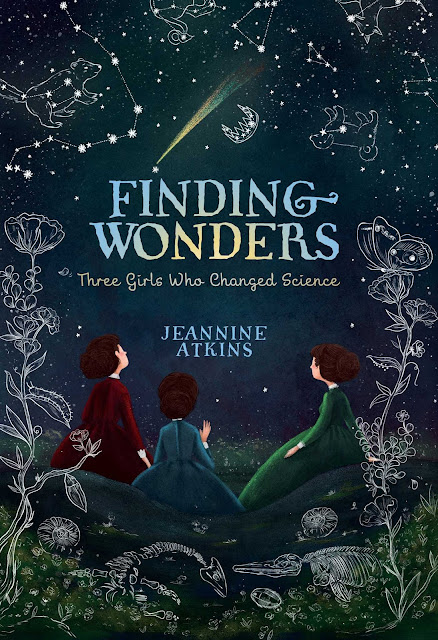Finding Wonders: Three Girls Who Changed Science by Jeanne Atkins, 208 pp, RL 4
Verse novels have proven to be a great way to get my students, mostly girls, reading longer, more complex books. My students are predominantly English Language Learners and reading at grade level, especially a book that is 200+ pages long, is a challenge to their comprehension skills and perseverance. The distilled style of writing found in verse novels allows them to persevere and comprehend what they are reading, while also tackling a more challenging text. Finding Wonders: Three Girls Who Changed Science by Jeannine Atkins is a perfect example of this. A non-fiction book about any of these subjects might be overwhelming for my students, as would a traditional novel. But, writing a verse novel allows the author an immediacy and intimacy that other genres might not. Jeanne Atkins brings this quality to Finding Wonders: Three Girls Who Changed Science, doing a marvelous job setting the stage for times and places where superstitions and religious beliefs, along with discrimination against women, stifled independent inquiry and scientific thought.
Atkins looks back to Germany in the 1600s for her first subject, Maria Sybilla Merian, then on to England in the 1800s to Mary Anning, ending with Maria (pronounced ma-RYA-ah) Mitchell in the United States in the late 1800s. With few words, Atkins makes the time and place, as well as the attitudes, vivid and real. She also makes clear the challenges that her subjects faced due to poverty and womanhood. All three women in Finding Wonders: Three Girls Who Changed Science overcame the challenges of womanhood, poverty, superstition and religion to pursue their passions, starting as children with inspiration and support from their fathers.
Maria Sybilla Merian's story begins in Frankfurt, Germany when she is thirteen. Trained to mix colors and paint nature by her step-father, a guild member, Maria keeps her fascination - and paintings - of caterpillars and butterflies secret due to superstitions of the time. When her step-father abandons the family, she is not allowed to sell her paintings because she is a woman. As an adult, Merian makes a move, and makes and documents her discoveries about how caterpillars become butterflies, eventually sailing to South America where she continued to study bugs, gaining a reputation as one of the foremost entomologists of her day. Possibly the best known of these three scientists and the inspiration for the tongue-twister "She Sells Seashells," Mary Anning also suffered most in her pursuits for being a woman. Atkins's verse is so powerful that I almost felt the cold sea spray and winds and felt the weight of the hammer that Mary and her father carried onto the beach as they scoured the cliffs for fossils. Mary's father dies, leaving the family even deeper in poverty, but she continues hunting. Atkins focuses on the discovery of the ichthyosaurus skeleton made by Mary and her brother Joseph, with growing tension between the two over who actually found it and who would decide what to do with it. While not included in the story told in Finding Wonders, I did learn that Mary Anning was continually discriminated against, despite her string of discoveries and research. Banned from joining the newly formed Geological Society of London - women were not even allowed to attend meetings, Anning was also slighted by fellow geologists who neglected to mention her name when writing about fossils she discovered. Atkins makes a nod to this in her text when, as the ichthyosaurus is being carried into town, a journalist asks young Mary who found it and, knowing that she did the lion's share of the work, nods to her brother, who then gets the notoriety.
Finally, Maria Mitchell, born into a Quaker family on Nantucket Island in 1818, grew up to become the first female astronomy professor in America. Taught by her father, who worked as a map maker and chronometer repairer, and fostered by the Quaker belief of intellectual equality between men and women, Maria thrived and excelled. In 1847 she discovered Miss Mitchell's comet and was awarded a gold medal prize by the King of Denmark. After this, American women took up funds to buy Maria a more powerful telescope and she even traveled the country and Europe, viewing the sky from various longitudes. Besides being a professor at Vassar, where she encouraged students that they were not too delicate to be educated, she worked as the first librarian at the Nantucket Atheneum for twenty years.
Atkins ends Finding Wonders: Three Girls Who Changed Science with two marvelous, brief chapters: A Note From the Author and Reading Past These Pages. Here, she provides more context for the works and lives of her subjects while also discussing the craft of writing a biography, especially when personal information and artifacts are limited. The selected bibliography is especially welcome in that Atkins includes books in Merian, Anning and Mitchell for adults and young readers. These fascinating, accomplished women are sure to interest readers well into adulthood.
Source: Purchased



